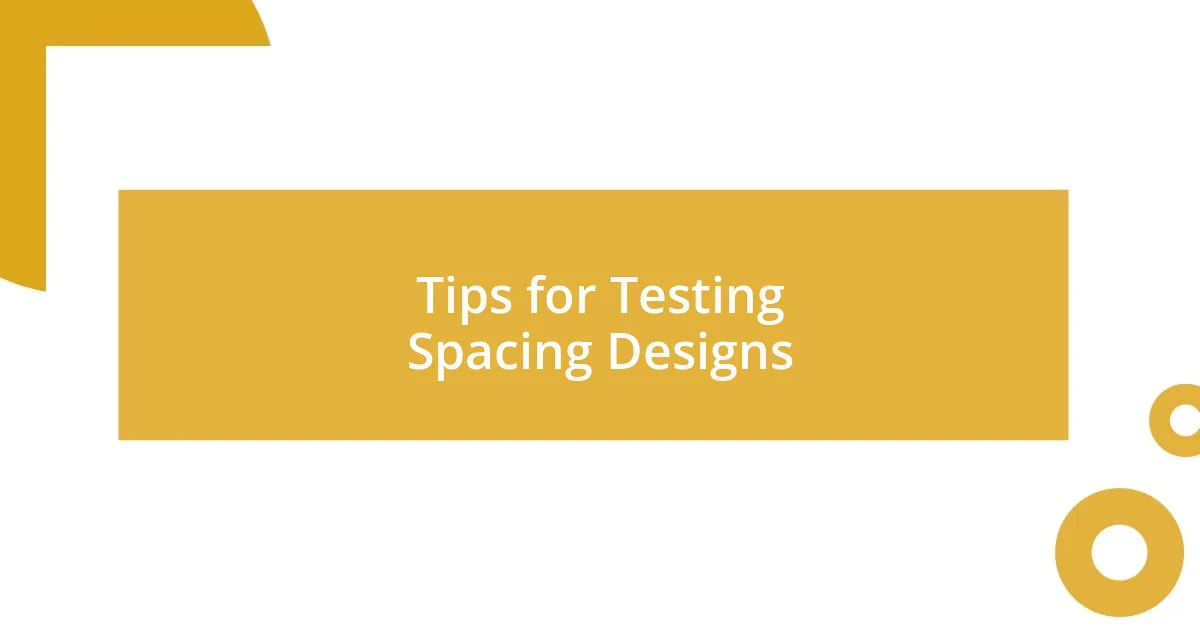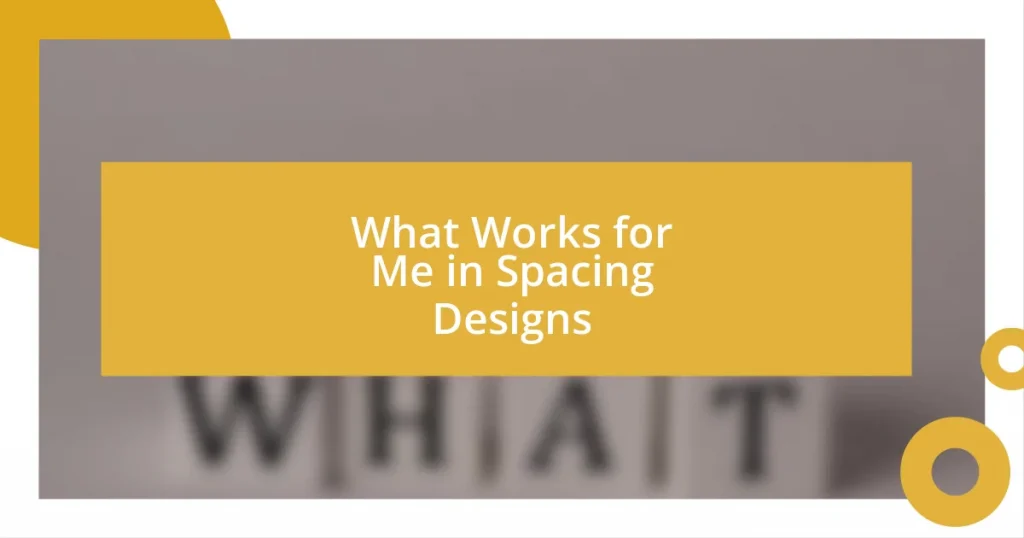Key takeaways:
- Understanding and applying effective spacing enhances readability, creates visual hierarchy, and fosters emotional connections with the audience.
- Consistent spacing and the use of grid systems offer structure, making designs more intuitive while allowing for creative expression.
- Adapting spacing for accessibility ensures inclusivity, improving navigation for users with different abilities and enhancing overall user experience.

Understanding Spacing in Design
When I first started learning about design, I was amazed at how much space itself could shape a piece. I remember creating a layout where I crammed all the elements together, thinking it would look more dynamic. Instead, it felt chaotic and overwhelming. It taught me that spacing isn’t just about aesthetics; it’s about guiding the viewer’s eye and creating a sense of harmony.
Have you ever noticed how a few well-placed white spaces can make vital information pop? I often find myself adjusting margins and padding, creating breathing room for certain elements. This small tweak can transform the entire vibe of a design, making it feel more polished and intentional. I’ve learned that spacing allows me to emphasize what really matters, helping the audience focus on key messages without distraction.
Exploring the psychological aspect of spacing has been eye-opening for me. There’s a certain calm that comes from well-spaced designs; it’s almost like a sigh of relief amidst the chaos of information overload. I believe that understanding spacing can significantly impact how we connect with our audience, making the design not just visually appealing but emotionally resonant as well.

Importance of Consistent Spacing
Consistent spacing in design can truly make a difference. I remember a project where I realized that uneven margins led to an unprofessional look, making it hard for the audience to engage. By applying a set spacing system, I found that the overall aesthetic improved, and the message became clearer.
Here are some key reasons why consistent spacing is crucial:
- Enhances Readability: When text is spaced evenly, it becomes easier to read and digest.
- Creates Visual Hierarchy: Consistent spacing guides the viewer’s attention to what’s important.
- Promotes Balance: A harmonious design feels more stable and inviting, creating a sense of trust.
- Facilitates Flow: Consistency in spacing ensures that the elements lead the viewer’s eye smoothly through the content.
- Reduces Cognitive Load: A well-spaced design minimizes distractions, allowing the audience to focus on the message rather than the layout.
I’ve often found that when I adhere to a spacing strategy, it feels like I’m planting tiny anchors throughout the design, keeping everything grounded and connected. This helps me foster an emotional response from the audience, as they feel more at ease navigating the content.

Applying Grid Systems Effectively
Using grid systems effectively in design has been a game-changer for me. Early on, I struggled with aligning elements, often leading to a cluttered look. However, once I embraced grid systems, everything clicked into place, literally and figuratively. The structured approach provided a framework that not only organized my designs but also allowed creativity to flourish within those boundaries. It’s fascinating how a simple grid can help maintain balance while also acting as a canvas for experimentation.
I’ve also noticed that grids can transform how my audience interacts with my designs. By organizing elements consistently, I’m able to guide their gaze naturally through the layout. For instance, in a recent project, utilizing a 12-column grid helped me create sections that were both engaging and intuitive to navigate. I can’t stress enough how empowering it feels when viewers engage without confusion. It’s a blend of responsiveness and intentionality that keeps users coming back.
Let’s break down some key differences in grid applications. Whether you’re working on web design or print, understanding these nuances can elevate your design approach significantly.
| Grid System | Application |
|---|---|
| Template Grid | Great for consistency across multiple pages. |
| Modular Grid | Ideal for complex layouts needing a flexible structure. |
| Hierarchical Grid | Perfect for prioritizing information and creating visual flow. |

Using White Space Wisely
Using white space wisely can dramatically affect how your design is perceived. I once worked on a portfolio where I thought cramming in more content would impress clients. Instead, it backfired. When I decided to let the white space breathe and arrange elements thoughtfully, the entire layout transformed. It became easier for viewers to focus on the key pieces, like my work and achievements, rather than feeling overwhelmed.
I find that white space is more than just empty areas; it’s a powerful tool that enhances communication. In a recent project, I strategically placed generous margins around my text and images. This not only drew attention to those elements but also provided a mental break for the audience. Have you ever noticed how much more inviting a design feels when there’s room to breathe? When I use white space, it’s like giving the audience a chance to absorb the information without feeling rushed or cramped.
On a more emotional level, white space creates an atmosphere of elegance and sophistication. I recall presenting a design with an abundance of white space, and the reactions were overwhelmingly positive. People felt calm and engaged, which is something I strive for in all my work. Ultimately, understanding and utilizing white space allows for a more empathetic design, where the user’s experience is at the forefront of my focus.

Balancing Elements Through Spacing
One of the most vital skills I’ve developed is balancing elements through spacing to achieve harmony in my designs. In one project, I was tasked with crafting a promotional flyer. By deliberately spacing out the text and images, I discovered that the design became more inviting. It’s incredible how just a little extra space can turn a chaotic layout into something cohesive and appealing.
I often ask myself, “How can I guide the viewer’s eye without overwhelming them?” I’ve found that by varying the spacing between elements, I can subtly influence how information is processed. For example, when I increased the spacing between headings and body text, the hierarchy became clearer. This change allowed my audience to skim the content effortlessly, which led to better engagement—a win-win situation!
Moreover, it’s fascinating how the emotional impact of a design can shift with spacing adjustments. I remember showcasing a project at a gallery where I intentionally left larger gaps between my artwork. Visitors commented that the space not only emphasized each piece but also allowed them to reflect individually. That experience reinforced my belief that proper spacing does more than balance elements; it creates a mood, inviting deeper appreciation and connection with the audience.

Adapting Spacing for Accessibility
When I think about adapting spacing for accessibility, I often recall a design project for a community resource website. I learned that increasing line spacing and font size made a significant difference for users with visual impairments. It was eye-opening to watch how these simple adjustments allowed more people to navigate the site independently, making the content feel inclusive and welcoming.
One of the challenges I faced was ensuring that color contrasts were appropriate while still maintaining ample spacing between elements. I remember experimenting with various layouts, always returning to the basic principle that accessibility shouldn’t detract from aesthetics. It struck me how thoughtfully placed elements not only enhanced readability but also fostered a sense of comfort. Have you ever considered how a little extra breathing room can transform a design from frustrating to enjoyable for someone navigating with a screen reader?
I find it incredibly rewarding when a design resonates with all users, including those with different abilities. There was a time I redesigned a flyer for an event and tested it with a group of diverse individuals. The feedback was enlightening; many appreciated how the spacious layout alleviated cognitive overload and allowed them to focus on key information. That experience reinforced my belief that adaptive spacing is essential to creating an empathetic design, making everyone feel seen and valued. It’s all about creating a space that invites every individual in!

Tips for Testing Spacing Designs
Testing spacing designs can be a fascinating journey. I often start by creating multiple mock-ups of the same layout, each with different spacing variations to see how they resonate. For instance, in one project, I spaced out the elements tightly in one version and kept them airy in another. It was surprising to observe how a simple shift in spacing could either crowd the information or give it room to breathe, clearly impacting the viewer’s preference.
When I conduct these tests, I always involve others. Inviting friends or colleagues to review my designs can yield valuable insights. I once presented three variations of a landing page to a small focus group. The feedback was enlightening—people appreciated the version with the most whitespace and declared it “stress-free.” That moment drove home the importance of external perspectives during the testing process; sometimes, what feels right to us may not translate the same to others.
Lastly, I’ve learned the value of intuition in spacing, especially after testing different designs. I remember a time when I instinctively adjusted the spacing on a business card layout after showing it to a few people. Their reactions were immediate; more space around the contact info made it feel more important. This taught me that while user testing is essential, trusting your gut can lead to delightful discoveries. How often do we overlook such subtle but impactful details in our work?















